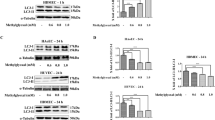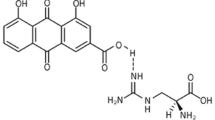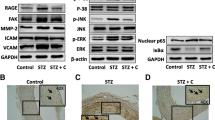Abstract
Advanced glycation end products (AGEs)-induced vasculopathy, including oxidative stress, inflammation and apoptosis responses, contributes to the high morbidity and mortality of coronary artery diseases in diabetic patients. The present study was conducted to evaluate the protective activity of liquiritin (Liq) on AGEs-induced endothelial dysfunction and explore its underlying mechanisms. After pretreatment with Liq, a significant reduction in AGEs-induced apoptosis, as well as reactive oxygen species generation and malondialdehyde level in human umbilical vein endothelial cells (HUVECs) were observed via acridine orange/ethidium bromide fluorescence staining test. Notably, Liq also significantly increased AGEs-reduced superoxide dismutase activity. Furthermore, the pretreatment with receptor for advanced glycation end products (RAGE)-antibody or Liq remarkably down-regulated TGF-beta1 and RAGE protein expressions and significantly blocked NF-κB activation which were proved by immunocytochemistry or immunofluorescence assays. These results indicated that Liq held potential for the protection on AGEs-induced endothelial dysfunction via RAGE/NF-κB pathway in HUVECs and might be a promising agent for the treatment of vasculopathy in diabetic patients.







Similar content being viewed by others
References
Klempfner R, Leor J, Tenenbaum A, Fisman EZ, Goldenberg I (2012) Effects of a vildagliptin/metformin combination on markers of atherosclerosis, thrombosis, and inflammation in diabetic patients with coronary artery disease. Cardiovasc Diabetol 11:60
Li FY, Lam KS, Tse HF, Chen C, Wang Y, Vanhoutte PM, Xu A (2012) Endothelium-selective activation of AMP-activated protein kinase prevents diabetes-induced impairment in vascular function and re-endothelialization via induction of heme oxygenase-1 in mice. Circulation. doi:10.1161/CIRCULATIONAHA.112.108159
Fels J, Jeggle P, Kusche-Vihrog K, Oberleithner H (2012) Cortical actin nanodynamics determines nitric oxide release in vascular endothelium. PLoS ONE 7:e41520
Karaman A, Bayram F, Gundogan K, Ozsan M, Karaman H, Kelestimur F (2012) Prevalence of diabetes mellitus and glucose metabolism disorders in the first degree relatives of type 2 diabetic patients. Bratisl Lek Listy 113:361–367
Takeuchi M, Iwaki M, Takino J, Shirai H, Kawakami M, Bucala R, Yamagishi S (2010) Immunological detection of fructose-derived advanced glycation end-products. Lab Invest 90:1117–1127
Jiang J, Chen P, Chen J, Yu X, Xie D, Mei C, Xiong F, Shi W, Zhou W, Liu X, Sun S, Zhang P, Yang X, Zhang Y, Zhang Y, Liang X, Zhang Z, Lin Q, Yu Y, Miyata T, Tian J, Liang M, Luo W, Xu X, Hou F (2012) Accumulation of tissue advanced glycation end products correlated with glucose exposure dose and associated with cardiovascular morbidity in patients on peritoneal dialysis. Atherosclerosis. doi:10.1016/j.atherosclerosis.2012.06.022
Ojima A, Matsui T, Maeda S, Takeuchi M, Yamagishi S (2012) Glucose-dependent insulinotropic polypeptide (GIP) inhibits signaling pathways of advanced glycation end products (AGEs) in endothelial cells via its antioxidative properties. Horm Metab Res 44:501–505
Lander HM, Tauras JM, Ogiste JS, Hori O, Moss RA, Schmidt AM (1997) Activation of the receptor for advanced glycation end products triggers a p21(ras)-dependent mitogen-activated protein kinase pathway regulated by oxidant stress. J Biol Chem 272:17810–17814
Sun YX, Tang Y, Wu AL, Liu T, Dai XL, Zheng QS, Wang ZB (2010) Neuroprotective effect of liquiritin against focal cerebral ischemia/reperfusion in mice via its antioxidant and antiapoptosis properties. J Asian Nat Prod Res 12:1051–1060
Zhao Z, Wang W, Guo H, Zhou D (2008) Antidepressant-like effect of liquiritin from Glycyrrhiza uralensis in chronic variable stress induced depression model rats. Behav Brain Res 194:108–113
Ko BS, Jang JS, Hong SM, Sung SR, Lee JE, Lee MY, Jeon WK, Park S (2007) Changes in components, glycyrrhizin and glycyrrhetinic acid, in raw Glycyrrhiza uralensis Fisch, modify insulin sensitizing and insulinotropic actions. Biosci Biotechnol Biochem 71:1452–1461
Franke S, Sommer M, Rüster C, Bondeva T, Marticke J, Hofmann G, Hein G, Wolf G (2009) Advanced glycation end products induce cell cycle arrest and proinflammatory changes in osteoarthritic fibroblast-like synovial cells. Arthritis Res Ther 11:R136
Xu Y, Feng L, Wang S, Zhu Q, Zheng Z, Xiang P, He B, Tang D (2011) Calycosin protects HUVECs from advanced glycation end products-induced macrophage infiltration. J Ethnopharmacol 137:359–370
Maeda S, Matsui T, Takeuchi M, Yoshida Y, Yamakawa R, Fukami K, Yamagishi S (2011) Pigment epithelium-derived factor (PEDF) inhibits proximal tubular cell injury in early diabetic nephropathy by suppressing advanced glycation end products (AGEs)-receptor (RAGE) axis. Pharmacol Res 63:241–248
Xu Y, Feng L, Wang S, Zhu Q, Lin J, Lou C, Xiang P, He B, Zheng Z, Tang D, Zuo G (2011) Phytoestrogen calycosin-7-O-β-d-glucopyranoside ameliorates advanced glycation end products-induced HUVEC damage. J Cell Biochem 112:2953–2965
Preethy CP, Padmapriya R, Periasamy VS, Riyasdeen A, Srinag S, Krishnamurthy H, Alshatwi AA, Akbarsha MA (2012) Antiproliferative property of n-hexane and chloroform extracts of Anisomeles malabarica (L). R. Br. in HPV16-positive human cervical cancer cells. J Pharmacol Pharmacother 3:26–34
Torreggiani M, Liu H, Wu J, Zheng F, Cai W, Striker G, Vlassara H (2009) Advanced glycation end product receptor-1 transgenic mice are resistant to inflammation, oxidative stress, and post-injury intimal hyperplasia. Am J Pathol 175:1722–1732
Wagener FA, Dekker D, Berden JH, Scharstuhl A, van der Vlag J (2009) The role of reactive oxygen species in apoptosis of the diabetic kidney. Apoptosis 14:1451–1458
Lee EY, Lee MY, Hong SW, Chung CH, Hong SY (2007) Blockade of oxidative stress by vitamin C ameliorates albuminuria and renal sclerosis in experimental diabetic rats. Yonsei Med J 48:847–855
Untergasser G, Gander R, Rumpold H, Heinrich E, Plas E, Berger P (2003) TGF-beta cytokines increase senescence-associated beta-galactosidase activity in human prostate basal cells by supporting differentiation processes, but not cellular senescence. Exp Gerontol 38:1179–1188
Guo ZJ, Niu HX, Hou FF, Zhang L, Fu N, Nagai R, Lu X, Chen BH, Shan YX, Tian JW, Nagaraj RH, Xie D, Zhang X (2008) Advanced oxidation protein products activate vascular endothelial cells via a RAGE-mediated signaling pathway. Antioxid Redox Signal 10:1699–1712
Yu S, Li H, Ma Y, Fu Y (2012) Matrix metalloproteinase-1 of gingival fibroblasts influenced by advanced glycation end products (AGEs) and their association with receptor for AGEs and nuclear factor-κB in gingival connective tissue. J Periodontol 83:119–126
Versari D, Daghini E, Virdis A, Ghiadoni L, Taddei S (2009) Endothelium-dependent contractions and endothelial dysfunction in human hypertension. Br J Pharmacol 157:527–536
Kinlay S, Libby P, Ganz P (2001) Endothelial function and coronary artery disease. Curr Opin Lipidol 12:383–389
Brunner H, Cockcroft JR, Deanfield J, Donald A, Ferrannini E, Halcox J, Kiowski W, Lüscher TF, Mancia G, Natali A, Oliver JJ, Pessina AC, Rizzoni D, Rossi GP, Salvetti A, Spieker LE, Taddei S, Webb DJ, Working group on endothelins and endothelial factors of the European society of hypertension (2005) Endothelial function and dysfunction. Part II: association with cardiovascular risk factors and diseases. A statement by the working group on endothelins and endothelial factors of the European society of hypertension. J Hypertens 23:233–246
Han SH, Kim YH, Mook-Jung I (2011) RAGE: the beneficial and deleterious effects by diverse mechanisms of actions. Mol Cells 31:91–97
Zhou X, Wang B, Zhu L, Hao S (2012) A novel improved therapy strategy for diabetic nephropathy: targeting AGEs. Organogenesis 8:18–21
Orasanu G, Plutzky J (2009) The pathologic continuum of diabetic vascular disease. J Am Coll Cardiol 53:S35–S42
Bengmark S (2006) Impact of nutrition on ageing and disease. Curr Opin Clin Nutr Metab Care 9:2–7
Brownlee M (2007) Preventing kidney cell suicide. Nat Med 13:1284–1285
Yamagishi S, Matsui T (2010) Advanced glycation end products, oxidative stress and diabetic nephropathy. Oxid Med Cell Longev 3:101–108
Partyka A, Lukaszewicz E, Niżański W (2012) Lipid peroxidation and antioxidant enzymes activity in avian semen. Anim Reprod Sci. doi:10.1016/j.anireprosci.2012.07.007
Nishikawa T, Edelstein D, Du XL, Yamagishi S, Matsumura T, Kaneda Y, Yorek MA, Beebe D, Oates PJ, Hammes HP, Giardino I, Brownlee M (2000) Normalizing mitochondrial superoxide production blocks three pathways of hyperglycaemic damage. Nature 404:787–790
Orr AW, Hahn C, Blackman BR, Schwartz MA (2008) p21-activated kinase signaling regulates oxidant-dependent NF-kappa B activation by flow. Circ Res 103:671–679
Barazzoni R, Zanetti M, Cappellari GG, Semolic A, Boschelle M, Codarin E, Pirulli A, Cattin L, Guarnieri G (2012) Fatty acids acutely enhance insulin-induced oxidative stress and cause insulin resistance by increasing mitochondrial reactive oxygen species (ROS) generation and nuclear factor-κB inhibitor (IκB)-nuclear factor-κB (NFκB) activation in rat muscle, in the absence of mitochondrial dysfunction. Diabetologia 55:773–782
Zheng Z, Chen H, Li J, Li T, Zheng B, Zheng Y, Jin H, He Y, Gu Q, Xu X (2012) Sirtuin 1-mediated cellular metabolic memory of high glucose via the LKB1/AMPK/ROS pathway and therapeutic effects of metformin. Diabetes 61:217–228
Kang R, Tang D, Lotze MT, Zeh HJ 3rd (2011) RAGE regulates autophagy and apoptosis following oxidative injury. Autophagy 7:442–444
Bierhaus A, Schiekofer S, Schwaninger M, Andrassy M, Humpert PM, Chen J, Hong M, Luther T, Henle T, Klöting I, Morcos M, Hofmann M, Tritschler H, Weigle B, Kasper M, Smith M, Perry G, Schmidt AM, Stern DM, Häring HU, Schleicher E, Nawroth PP (2001) Diabetes-associated sustained activation of the transcription factor nuclear factor-kappaB. Diabetes 50:2792–2808
Cheng M, Gao HQ, Xu L, Li BY, Zhang H, Li XH (2007) Cardioprotective effects of grape seed proanthocyanidins extracts in streptozocin induced diabetic rats. J Cardiovasc Pharmacol 50:503–509
Williams ME, Bolton WK, Khalifah RG, Degenhardt TP, Schotzinger RJ, McGill JB (2007) Effects of pyridoxamine in combined phase 2 studies of patients with type 1 and type 2 diabetes and overt nephropathy. Am J Nephrol 27:605–614
An Y, Zhang Y, Li C, Qian Q, He W, Wang T (2011) Inhibitory effects of flavonoids from Abelmoschus manihot flowers on triglyceride accumulation in 3T3-L1 adipocytes. Fitoterapia 82:595–600
Acknowledgments
We sincerely acknowledge Natural Science Foundation of Jiangsu Province (BK2012491), National Natural Science Foundation of China, and Leading Talent Foundation of Jiangsu Chinese Medicine (2006) for providing financial support.
Conflict of interest
We declare that there is no conflict of interest. No author has any financial interest or conflict of interest involved with this study.
Author information
Authors and Affiliations
Corresponding author
Rights and permissions
About this article
Cite this article
Zhang, X., Song, Y., Han, X. et al. Liquiritin attenuates advanced glycation end products-induced endothelial dysfunction via RAGE/NF-κB pathway in human umbilical vein endothelial cells. Mol Cell Biochem 374, 191–201 (2013). https://doi.org/10.1007/s11010-012-1519-0
Received:
Accepted:
Published:
Issue Date:
DOI: https://doi.org/10.1007/s11010-012-1519-0




